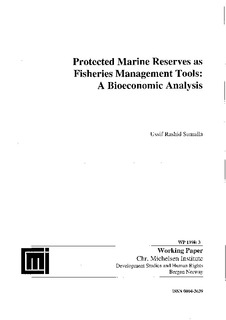| dc.description.abstract | This paper develops a dynamic computational bioeconomic model with the objective of assessing protected marine reserves as fisheries management tools. Data on the North East Atlantic cod stock are used to determine the bioeconomically optimal size of a marine reserve for the Barents Sea cod fishery, as a function of the net transfer rate between the protected and unprotected areas of the marine habitat. The single agent model developed, allows for the occurrence of a shock to the system in the form of severe recruitment failure in the non-protected area. Two key results emerge from the study. First, establishment of marine reserves are bioeconomically beneficial when net transfer rates for cod are "reasonably" high and reserve sizes are large: Large reserves provide good protection for the stock in the face of the shock, while high transfer rates make the protected fish available for harvesting after the shock has occurred. Further, optimally chosen reserve size when net transfer rates are high, also mitigates against biological losses. Second, when net transfer rates are low, the establishment of marine reserves does not mitigate against losses in discounted economic rent, while they tend to be efficient in mitigating against biological losses. | |
